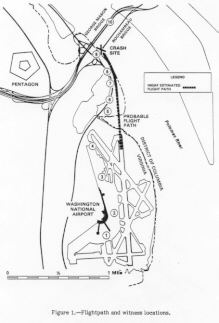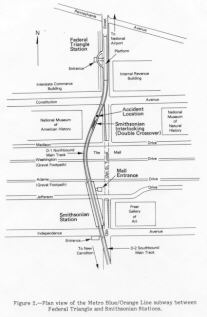
| 14th
Street Bridge, the Air Florida Crash, and Subway Disaster |
The Air Florida crash
on Wednesday, January 13, 1982 is very well covered, from an aviation standpoint,
on several aviation disaster websites that I have seen. I will discuss the ground
transportation standpoint of this disaster, as well as the unrelated subway disaster
that occurred about one half hour later.
There was a major snowstorm that was
covering the Washington, D.C. area with considerable accumulation, and there was
an early release of federal employees, and heavy strain on the region's transportation
system.
The plane had taken off from nearby
Washington National Airport, and due to wing
icing and pilot error, the aircraft lost altitude and crashed into the 14th Street
Bridge and the Potomac River less than a mile from the airport. There were only
5 survivors out of 79 people on board. The plane was a Boeing 737 two-engine jet
airliner that was Air Florida Flight 90. The aircraft descended nose-high and
tail-low, and at 4:01 PM, the tail struck the deck and parapet of the Rochambeau
Bridge (the northbound span), struck seven vehicles, killed 4 motorists and injured
4 motorists, and went into the frozen river between the Rochambeau Bridge and
the express span (they are a couple hundred yards apart). The aircraft shattered
the surface ice, and broke into multiple large pieces which quickly sank into
the river. There were a total of 78 fatalities. Traffic was already stopped in
a traffic jam, due to the storm. Between the effects of the storm, and the rescue
efforts around the 14th Street (I-395/US-1) bridges, the 12-lane complex ceased
to function, and closed to traffic. The George Washington Parkway, which parallels
the Potomac River in Virginia, also closed near the crash site.
A rapid rail transit accident occurred
about one half hour after the air crash. At 4:30 PM, one car of a
WMATA Metrorail train derailed while the train
was being backed up through a crossover switch south of the Federal Triangle Station
in D.C., and the car was pulled sideways and it crashed into the concrete pillar
separating the inbound and outbound subway tunnels. A misaligned switch at Smithsonian
Interlocking caused the rear wheel truck to derail, and the wheels tracked alongside
of the rails for 171 feet, following the opposite track, until the car impacted
the concrete pillar. There were 3 fatalities, and 25 injuries. Investigations
identified human operational error as the primary cause.
This occurred on the Blue/Orange Line,
and resulted in the both lines being shut down. At that time, the Blue Line ran
from National Airport Station in Arlington to Addison Road Station in Maryland,
and the Orange Line ran from Ballston Station in Arlington to New Carrolton Station
in Maryland. The derailment occurred on the section where the two lines share
the same cross-town subway route, and the wrecked subway car blocked both tracks.
The other (then) open line, the Red Line, was not affected.
So in a one hour period, the D.C. area
lost the use of its (at that time) busiest airport, busiest expressway, and busiest
subway line. The (by far) widest/busiest bridge from D.C. to Virginia closed,
and the one rapid rail transit line from D.C. to Virginia closed. This was a true
area-wide transportation disaster, a major chunk of the air, highway, and rail
system closed.
From "Series of Disasters Paralyzes
Capital Area at Rush Hour", The Washington Post, January 14, 1982:
"The series of disasters locked tens of thousands of commuters in a monumental
traffic jam yesterday afternoon and into the night. Scores of drivers, confused
and frustrated that their normal routes home were blocked and bridges snarled
with traffic, simply walked away from their cars. Many motorists waited in bars
and checked into Washington hotels. The 14th Street Bridge, the major traffic
artery into the city from Virginia, will be closed today while officials continue
their investigation, salvage and damage assessment efforts in the wake of the
airplane crash. Inbound traffic on I-395 will be funneled over Memorial Bridge.
Metro officials explained that the Blue and Orange Lines, which carry traffic
into the city from Virginia, will terminate at McPherson Square. The same lines
bringing passengers into the District from New Carrolton and Addison Road in suburban
Maryland, will end at the Federal Center Southwest Station. Busses will be used
to ferry passengers between McPherson Square and Federal Center Southwest while
crews work on the damage to the line near the Smithsonian Station".
The subway accident had no connection
whatsoever with the air crash. The snowstorm put increased passenger loads on
Metro, but that is a casual factor at best for causing the derailment.
Due to the proximity of the air crash
to the airport, and due to the fact that National has only one jet airliner runway,
it closed at 4:28 PM and didn't reopen until 7:00 AM the next morning. The 14th
Street Bridge spans were used as a staging area for salvage and support operations
for the crash site, and it was about two weeks before the complex was fully reopened,
although the southbound span reopened a day after the crash, and the repaired
northbound span reopened 3 days after the crash. A temporary repair to the Rochambeau
Bridge was effected where the plane hit and ripped out about 100 feet of parapet.
Due to the sub-freezing weather and heavy ice conditions on the river, it took
two to three weeks to retrieve the aircraft wreckage and fatalities from the river.
The water is 25 to 30 feet deep where the plane crashed, about 150 feet from the
south shoreline.
The removal of the demolished subway
car from the subway tunnel was difficult. It had to be taken apart and taken out
in pieces. The destroyed tracks had to be rebuilt. The accident occurred at an
interlocking (crossover) section of line. It took 5 days for the subway tunnel
at the accident site to be reopened to train service.
During the period of closures of the
subway tunnel and the 14th Street Bridge, there were major traffic and transit
jams. Ten-mile-long peak period backups were common on some major thoroughfares.
Some trips that ordinarily took 40 minutes by auto or transit, took 3 to 4 hours,
and peak periods stretched far beyond normal peak period times. The snowstorm
on the day of the disasters dropped an average of 6 inches of snow, and many places
got 4 more inches by the next morning. Snow removal was complicated by sub-freezing
temperatures and generally bad traffic conditions.
See my
14th Street Bridge Complex (I-395 and US-1)
article for detailed information about the bridge complex. The Rochambeau Bridge
was later renamed the Arland D. Williams, Jr. Memorial Bridge, after the heroic
Flight 90 passenger who perished while saving others from the icy waters.
"He was about 50 years old, one of
half a dozen survivors clinging to twisted wreckage bobbing in the icy Potomac
when the first helicopter arrived. To the copter's two-man Park Police crew he
seemed the most alert. Life vests were dropped, then a flotation ball. The man
passed them to the others. On two occasions, the crew recalled last night, he
handed away a life line from the hovering machine that could have dragged him
to safety. The helicopter crew - who rescued five people, the only persons who
survived from the jetliner - lifted a woman to the riverbank, then dragged three
more persons across the ice to safety. Then the life line saved a woman who was
trying to swim away from the sinking wreckage, and the helicopter pilot, Donald
W. Usher, returned to the scene, but the man was gone," from "A Hero - Passenger
Aids Others, Then Dies", The Washington Post, January 14, 1982.
Sources:
National Transportation Safety Board (NTSB)
accident reports for the two accidents (NTSB-AAR-82-8 and NTSB-RAR-82-6), plus
articles from The Washington Post,
January 14 to 20, 1982. See also the Aviation Safety Network,
Aircraft accident
description 13.01.1982 Boeing 737-222. See also Andrew Ayers' webpage for
the Flight 90 Crash. See
also AirDisaster.Com,
Special Report:
Air Florida Flight 90.
Copyright © 1997-2002 by Scott Kozel. All rights reserved. Reproduction, reuse,
or distribution without permission is prohibited.
Back to top
By Scott M. Kozel,
Roads to the Future
(Created 8-14-1997; last updated 9-16-2002)


